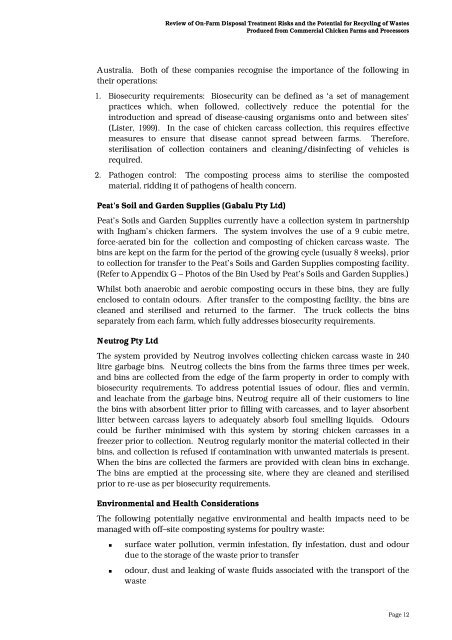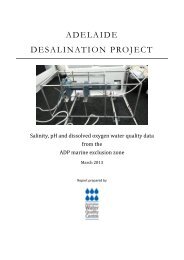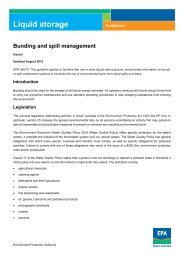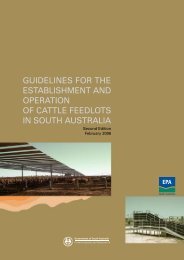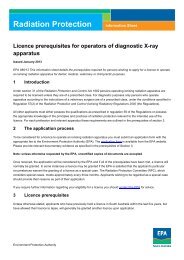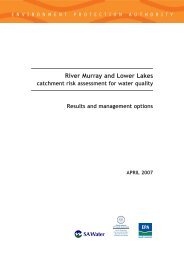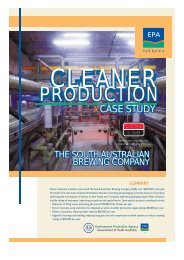Commercial Chicken Farms and Processors - EPA
Commercial Chicken Farms and Processors - EPA
Commercial Chicken Farms and Processors - EPA
You also want an ePaper? Increase the reach of your titles
YUMPU automatically turns print PDFs into web optimized ePapers that Google loves.
Review of On-Farm Disposal Treatment Risks <strong>and</strong> the Potential for Recycling of Wastes<br />
Produced from <strong>Commercial</strong> <strong>Chicken</strong> <strong>Farms</strong> <strong>and</strong> <strong>Processors</strong><br />
Australia. Both of these companies recognise the importance of the following in<br />
their operations:<br />
1. Biosecurity requirements: Biosecurity can be defined as ‘a set of management<br />
practices which, when followed, collectively reduce the potential for the<br />
introduction <strong>and</strong> spread of disease-causing organisms onto <strong>and</strong> between sites’<br />
(Lister, 1999). In the case of chicken carcass collection, this requires effective<br />
measures to ensure that disease cannot spread between farms. Therefore,<br />
sterilisation of collection containers <strong>and</strong> cleaning/disinfecting of vehicles is<br />
required.<br />
2. Pathogen control: The composting process aims to sterilise the composted<br />
material, ridding it of pathogens of health concern.<br />
Peat’s Soil <strong>and</strong> Garden Supplies (Gabalu Pty Ltd)<br />
Peat’s Soils <strong>and</strong> Garden Supplies currently have a collection system in partnership<br />
with Ingham’s chicken farmers. The system involves the use of a 9 cubic metre,<br />
force-aerated bin for the collection <strong>and</strong> composting of chicken carcass waste. The<br />
bins are kept on the farm for the period of the growing cycle (usually 8 weeks), prior<br />
to collection for transfer to the Peat’s Soils <strong>and</strong> Garden Supplies composting facility.<br />
(Refer to Appendix G – Photos of the Bin Used by Peat’s Soils <strong>and</strong> Garden Supplies.)<br />
Whilst both anaerobic <strong>and</strong> aerobic composting occurs in these bins, they are fully<br />
enclosed to contain odours. After transfer to the composting facility, the bins are<br />
cleaned <strong>and</strong> sterilised <strong>and</strong> returned to the farmer. The truck collects the bins<br />
separately from each farm, which fully addresses biosecurity requirements.<br />
Neutrog Pty Ltd<br />
The system provided by Neutrog involves collecting chicken carcass waste in 240<br />
litre garbage bins. Neutrog collects the bins from the farms three times per week,<br />
<strong>and</strong> bins are collected from the edge of the farm property in order to comply with<br />
biosecurity requirements. To address potential issues of odour, flies <strong>and</strong> vermin,<br />
<strong>and</strong> leachate from the garbage bins, Neutrog require all of their customers to line<br />
the bins with absorbent litter prior to filling with carcasses, <strong>and</strong> to layer absorbent<br />
litter between carcass layers to adequately absorb foul smelling liquids. Odours<br />
could be further minimised with this system by storing chicken carcasses in a<br />
freezer prior to collection. Neutrog regularly monitor the material collected in their<br />
bins, <strong>and</strong> collection is refused if contamination with unwanted materials is present.<br />
When the bins are collected the farmers are provided with clean bins in exchange.<br />
The bins are emptied at the processing site, where they are cleaned <strong>and</strong> sterilised<br />
prior to re-use as per biosecurity requirements.<br />
Environmental <strong>and</strong> Health Considerations<br />
The following potentially negative environmental <strong>and</strong> health impacts need to be<br />
managed with off–site composting systems for poultry waste:<br />
¢ surface water pollution, vermin infestation, fly infestation, dust <strong>and</strong> odour<br />
due to the storage of the waste prior to transfer<br />
¢ odour, dust <strong>and</strong> leaking of waste fluids associated with the transport of the<br />
waste<br />
Page 12


